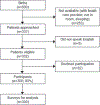Patient Preferences for Prenatal and Postpartum Care Delivery: A Survey of Postpartum Women
- PMID: 32282598
- PMCID: PMC7183878
- DOI: 10.1097/AOG.0000000000003731
Patient Preferences for Prenatal and Postpartum Care Delivery: A Survey of Postpartum Women
Abstract
Objective: To describe patients' preferences for prenatal and postpartum care delivery.
Methods: We conducted a cross-sectional survey of postpartum patients admitted for childbirth and recovery at an academic institution. We assessed patient preferences for prenatal and postpartum care delivery, including visit number, between-visit contact (eg, phone and electronic medical record portal communication), acceptability of remote monitoring (eg, weight, blood pressure, fetal heart tones), and alternative care models (eg, telemedicine and home visits). We compared preferences for prenatal care visit number to current American College of Obstetricians and Gynecologists' recommendations (12-14 prenatal visits).
Results: Of the 332 women eligible for the study, 300 (90%) completed the survey. Women desired a median number of 10 prenatal visits (interquartile range 9-12), with most desiring fewer visits than currently recommended (fewer than 12: 63% [n=189]; 12-14: 22% [n=65]; more than 14: 15% [n=46]). Women who had private insurance or were white were more likely to prefer fewer prenatal visits. The majority of patients desired contact with their care team between visits (84%). Most patients reported comfort with home monitoring skills, including measuring weight (91%), blood pressure (82%), and fetal heart tones (68%). Patients reported that they would be most likely to use individual care models (94%), followed by pregnancy medical homes (72%) and home visits (69%). The majority of patients desired at least two postpartum visits (91%), with the first visit within 3 weeks after discharge (81%).
Conclusion: Current prenatal and postpartum care delivery does not match patients' preferences for visit number or between-visit contact, and patients are open to alternative models of prenatal care, including remote monitoring. Future prenatal care redesign will need to consider diverse patients' preferences and flexible models of care that are tailored to work with patients in the context of their lives and communities.
Figures


Similar articles
-
Randomized comparison of a reduced-visit prenatal care model enhanced with remote monitoring.Am J Obstet Gynecol. 2019 Dec;221(6):638.e1-638.e8. doi: 10.1016/j.ajog.2019.06.034. Epub 2019 Jun 19. Am J Obstet Gynecol. 2019. PMID: 31228414 Clinical Trial.
-
Patient and provider perspectives of a new prenatal care model introduced in response to the coronavirus disease 2019 pandemic.Am J Obstet Gynecol. 2021 Apr;224(4):384.e1-384.e11. doi: 10.1016/j.ajog.2020.10.008. Epub 2020 Oct 8. Am J Obstet Gynecol. 2021. PMID: 33039393 Free PMC article.
-
Adoption of virtual prenatal visits linked to recurrent virtual or forgone visits for postpartum care.Midwifery. 2024 Feb;129:103904. doi: 10.1016/j.midw.2023.103904. Epub 2023 Dec 5. Midwifery. 2024. PMID: 38070218
-
A Review of Prenatal Care Delivery to Inform the Michigan Plan for Appropriate Tailored Healthcare in Pregnancy Panel.Obstet Gynecol. 2021 Oct 1;138(4):603-615. doi: 10.1097/AOG.0000000000004535. Obstet Gynecol. 2021. PMID: 34352841
-
The evolution of prenatal care delivery guidelines in the United States.Am J Obstet Gynecol. 2021 Apr;224(4):339-347. doi: 10.1016/j.ajog.2020.12.016. Epub 2020 Dec 13. Am J Obstet Gynecol. 2021. PMID: 33316276 Free PMC article. Review.
Cited by
-
Quality of prenatal and postpartum telehealth visits during COVID-19 and preferences for future care.AJOG Glob Rep. 2023 Feb;3(1):100139. doi: 10.1016/j.xagr.2022.100139. Epub 2022 Nov 26. AJOG Glob Rep. 2023. PMID: 36465317 Free PMC article.
-
An Evidence-Based Framework for Creating Inclusive and Personalized mHealth Solutions-Designing a Solution for Medicaid-Eligible Pregnant Individuals With Uncontrolled Type 2 Diabetes.JMIR Diabetes. 2023 Oct 12;8:e46654. doi: 10.2196/46654. JMIR Diabetes. 2023. PMID: 37824196 Free PMC article.
-
Telehealth Utilization in High-Risk Pregnancies During COVID-19.Telemed Rep. 2023 May 15;4(1):61-66. doi: 10.1089/tmr.2023.0006. eCollection 2023. Telemed Rep. 2023. PMID: 37283855 Free PMC article.
-
Covid-19: Exposing the Lack of Evidence-Based Practice in Medicine.Hastings Cent Rep. 2020 May;50(3):77-78. doi: 10.1002/hast.1144. Hastings Cent Rep. 2020. PMID: 32596912 Free PMC article.
-
Perinatal Outcomes Among Patients Using OB Teleflex, A Hybrid Prenatal Telemedicine Program.J Obstet Gynaecol Can. 2025 Jun;47(6):102911. doi: 10.1016/j.jogc.2025.102911. Epub 2025 Apr 18. J Obstet Gynaecol Can. 2025. PMID: 40254095
References
-
- Osterman MJK, Martin JA. Timing and Adequacy of Prenatal Care in the United States, 2016. Natl Vital Stat Rep 2018;67:1–14. - PubMed
-
- American College of Obsetetricians and Gynecologists. ACOG Committee Opinion No. 736: Optimizing Postpartum Care. Obstet Gynecol 2018;131:e140–e150. - PubMed
-
- Michigan Quality Improvement Consortium. Routine Prenatal and Postnatal Care. Available at: http://www.mqic.org/pdf/2018_mqic_routine_prenatal_and_postnatal_care_cp.... Retrieved May 28, 2019.
-
- Kaiser Permanente Guideline Oversight Group. Prenatal Care Screening and Testing Guideline. Available at: https://wa.kaiserpermanente.org/static/pdf/public/guidelines/prenatal.pdf. Retrieved May 28, 2019.
-
- Viswanathan M, Treiman KA, Kish-Doto J, Middleton JC, Coker-Schwimmer EJ, Nicholson WK. Folic Acid Supplementation for the Prevention of Neural Tube Defects: An Updated Evidence Report and Systematic Review for the US Preventive Services Task Force. JAMA 2017;317:190–203. - PubMed
Publication types
MeSH terms
Grants and funding
LinkOut - more resources
Full Text Sources
Medical

